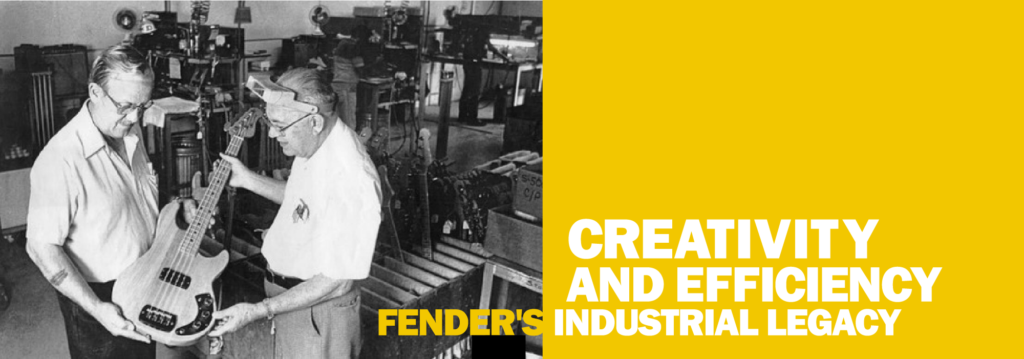
Leo Fender: Innovation and Passion in Guitar-Making
Leo Fender, born on August 10, 1909, in Anaheim, California, didn’t just make guitars—he reshaped the sound of modern music. In 1946, he started the Fender Electric Instrument Manufacturing Company. Just a few years later, in 1950, he introduced the Telecaster, the world’s first mass-produced solid-body electric guitar.
Then, in 1954, came the Stratocaster. It wasn’t just a guitar; it was a game-changer. Its sleek, contoured body made it more comfortable to play, and the three single-coil pickups gave players unmatched tonal flexibility.
Of course, Leo didn’t do it all on his own. His close collaborator, George Fullerton, played a key role in bringing Fender’s ideas to life, and Freddie Tavares contributed to the design of the legendary Stratocaster. Together, they created instruments that blended function and style in a way no one had seen before.
Even after selling his company to CBS in 1965, Leo’s passion didn’t stop. He went on to start Music Man in 1971 and G&L Musical Instruments in 1979, continuing to push the boundaries of guitar design.
Today, every Fender guitar carries on his legacy, inspiring luthiers and musicians worldwide. Leo’s hands-on approach and obsession with quality still set the bar for guitar-making.
The Guitar Market in the 1950s
When Leo Fender introduced the Telecaster in 1950, the guitar world was dominated by archtop acoustics and electrics, along with lap steel guitars popular in country and western music. Hollow-body electric guitars, while beautiful, had one big issue: feedback. Plus, they weren’t as durable or easy to mass-produce.
The Telecaster changed all that. Its solid body eliminated feedback issues, and it could be mass-produced with consistent quality. This innovation grabbed the attention of musicians across genres and firmly established Fender as a pioneer in the music industry.
With its versatility, reliability, and accessibility, Fender’s guitars set a new standard. They made it easier than ever for musicians to explore the possibilities of electric music, sparking a revolution that continues today.
The Telecaster and Stratocaster: Leo Fender’s Icons
In 1950, Leo Fender unveiled the Telecaster, the first mass-produced solid-body electric guitar. Made from ash for the body and maple for the neck, the Telecaster featured two single-coil pickups that delivered a bright, clear tone that became its signature.
Then came the Stratocaster in 1954, with its contoured body that hugged the player’s body and offered unparalleled comfort. The three single-coil pickups made it one of the most versatile guitars ever, and the synchronized tremolo bridge allowed players to add vibrato effects with ease. Using alder for the body and maple for the neck gave the Stratocaster its distinct, punchy sound, making it a favorite for generations of musicians.


The Precision Bass: Reinventing the Bass Guitar
In 1951, just a year after the Telecaster, Leo Fender introduced another revolutionary instrument: the Precision Bass. This was the world’s first mass-produced solid-body bass guitar, and it changed the role of bassists forever. Compact, easy to amplify, and powerful, it was a game-changer compared to the bulky upright basses of the time.
The Precision Bass featured an alder body and a maple neck, along with a split-coil pickup that captured each string individually. This design delivered a clean, punchy tone that cut through any mix. It also had a bridge with four adjustable saddles, allowing players to fine-tune intonation and string action.
The Precision Bass not only gave bassists more freedom on stage but also brought a new level of consistency to bass tone. From jazz to rock to funk, it quickly became a staple across all genres. To this day, it’s the go-to bass for countless players, and its influence on modern music is undeniable.
From Radio Repair to Iconic Amps: Leo Fender’s Amplifiers
Before shaking up the guitar world, Leo Fender ran a radio repair shop called Fender Radio Service. His background in electronics and sound equipment was key to his later success in designing amps.
Fender amplifiers, like the legendary Twin Reverb, became famous for their sound quality and durability. Released in 1963, the Twin Reverb delivered a powerful, clean tone with a built-in reverb effect that guitarists instantly fell in love with.
Leo’s experience with radios gave him an edge when it came to designing reliable, high-performance amplifiers. Using top-notch components and solid construction, he created amps that could handle the demands of touring musicians.
Even today, Fender amps like the Twin Reverb and Deluxe Reverb remain favorites among guitarists for their timeless tone and unbeatable reliability.


Leo Fender: Innovation and Passion in Guitar-Making
Leo Fender, born on August 10, 1909, in Anaheim, California, didn’t just make guitars—he reshaped the sound of modern music. In 1946, he started the Fender Electric Instrument Manufacturing Company. Just a few years later, in 1950, he introduced the Telecaster, the world’s first mass-produced solid-body electric guitar.
Then, in 1954, came the Stratocaster. It wasn’t just a guitar; it was a game-changer. Its sleek, contoured body made it more comfortable to play, and the three single-coil pickups gave players unmatched tonal flexibility.
Of course, Leo didn’t do it all on his own. His close collaborator, George Fullerton, played a key role in bringing Fender’s ideas to life, and Freddie Tavares contributed to the design of the legendary Stratocaster. Together, they created instruments that blended function and style in a way no one had seen before.
Even after selling his company to CBS in 1965, Leo’s passion didn’t stop. He went on to start Music Man in 1971 and G&L Musical Instruments in 1979, continuing to push the boundaries of guitar design.
Today, every Fender guitar carries on his legacy, inspiring luthiers and musicians worldwide. Leo’s hands-on approach and obsession with quality still set the bar for guitar-making.
The Guitar Market in the 1950s
When Leo Fender introduced the Telecaster in 1950, the guitar world was dominated by archtop acoustics and electrics, along with lap steel guitars popular in country and western music. Hollow-body electric guitars, while beautiful, had one big issue: feedback. Plus, they weren’t as durable or easy to mass-produce.
The Telecaster changed all that. Its solid body eliminated feedback issues, and it could be mass-produced with consistent quality. This innovation grabbed the attention of musicians across genres and firmly established Fender as a pioneer in the music industry.
With its versatility, reliability, and accessibility, Fender’s guitars set a new standard. They made it easier than ever for musicians to explore the possibilities of electric music, sparking a revolution that continues today.
The Telecaster and Stratocaster: Leo Fender’s Icons
In 1950, Leo Fender unveiled the Telecaster, the first mass-produced solid-body electric guitar. Made from ash for the body and maple for the neck, the Telecaster featured two single-coil pickups that delivered a bright, clear tone that became its signature.
Then came the Stratocaster in 1954, with its contoured body that hugged the player’s body and offered unparalleled comfort. The three single-coil pickups made it one of the most versatile guitars ever, and the synchronized tremolo bridge allowed players to add vibrato effects with ease. Using alder for the body and maple for the neck gave the Stratocaster its distinct, punchy sound, making it a favorite for generations of musicians.

The Precision Bass: Reinventing the Bass Guitar
In 1951, just a year after the Telecaster, Leo Fender introduced another revolutionary instrument: the Precision Bass. This was the world’s first mass-produced solid-body bass guitar, and it changed the role of bassists forever. Compact, easy to amplify, and powerful, it was a game-changer compared to the bulky upright basses of the time.
The Precision Bass featured an alder body and a maple neck, along with a split-coil pickup that captured each string individually. This design delivered a clean, punchy tone that cut through any mix. It also had a bridge with four adjustable saddles, allowing players to fine-tune intonation and string action.
The Precision Bass not only gave bassists more freedom on stage but also brought a new level of consistency to bass tone. From jazz to rock to funk, it quickly became a staple across all genres. To this day, it’s the go-to bass for countless players, and its influence on modern music is undeniable.

From Radio Repair to Iconic Amps: Leo Fender’s Amplifiers
Before shaking up the guitar world, Leo Fender ran a radio repair shop called Fender Radio Service. His background in electronics and sound equipment was key to his later success in designing amps.
Fender amplifiers, like the legendary Twin Reverb, became famous for their sound quality and durability. Released in 1963, the Twin Reverb delivered a powerful, clean tone with a built-in reverb effect that guitarists instantly fell in love with.
Leo’s experience with radios gave him an edge when it came to designing reliable, high-performance amplifiers. Using top-notch components and solid construction, he created amps that could handle the demands of touring musicians.
Even today, Fender amps like the Twin Reverb and Deluxe Reverb remain favorites among guitarists for their timeless tone and unbeatable reliability.





